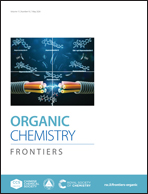CO2 and palladium enabled highly chemoselective hydroxylation of gem-difluorocyclopropanes†
Abstract
The CO2-mediated hydroxylation of gem-difluorocyclopropanes is herein described, under Pd(0) catalysis in the presence of H2O. The method affords a large series of valuable fluorinated cinnamyl alcohols in high yields and with broad functional group tolerance. It is moreover highly chemoselective, as the double C–O coupled ether side-product could be completely suppressed under the CO2 atmosphere. The reaction occurs through Pd-catalyzed C–C and C–F bond activation on the one hand, while CO2 is proposed to activate the weak water nucleophile on the other. This mild synthetic method should impact the fields of medicinal chemistry, organic synthesis, and sustainable processes and advance the concept of CO2 catalysis.



 Please wait while we load your content...
Please wait while we load your content...